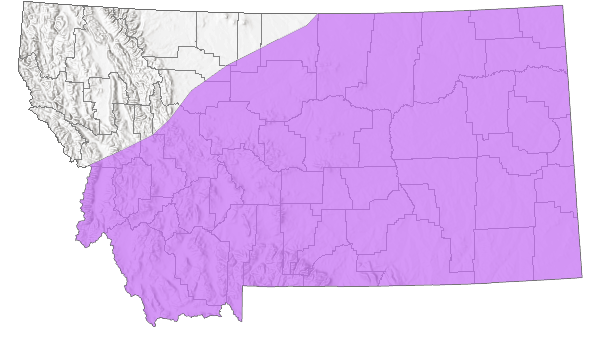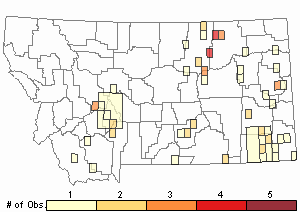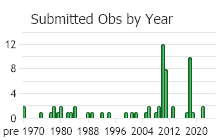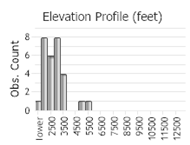View in other NatureServe Network Field Guides
NatureServe
Montana
Utah
Wyoming
Idaho
Wisconsin
British Columbia
South Carolina
Yukon
California
New York
False Buffalograss - Munroa squarrosa
Other Names:
Monroa squarrosa [orth. rej.]
Native Species
Global Rank:
G5
State Rank:
S4
(see State Rank Reason below)
C-value:
Agency Status
USFWS:
USFS:
BLM:
External Links
State Rank Reason (see State Rank above)
Munroa squarrosa occurs from southwest to eastern Montana. It grows in dry open areas, such as grasslands, shrubby grasslands, roadsides, overgrazed pastures, farmyards, prairie dog towns, and where soils are sandy. It grows well in disturbed places.
- Details on Status Ranking and Review
Range Extent
ScoreG - 200,000-2,500,000 sq km (~80,000-1,000,000 sq mi)
Area of Occupancy
ScoreE - 26-125 4-km2 grid cells
Number of Populations
ScoreC - 21 - 80
Number of Occurrences or Percent Area with Good Viability / Ecological Integrity
ScoreC - Few (4-12) occurrences with excellent or good viability or ecological integrity
Environmental Specificity
ScoreD - Broad. Generalist or community with all key requirements common
Threats
ScoreD - Low
General Description
PLANTS: Warm season, annual bunchgrass. Stems often mat-forming, 3–10 cm (Lesica et al. 2012). Plants are stoloniferous (FNA 2003). Plants are white-hairy; these hairs are delicate and prone to falling off when the plants are collected.
LEAVES: Blades 1.5–2.5 mm wide, flat and ascending, and clustered at nodes (Lesica et al. 2012). Leaves sometimes have a purple tinge (FNA 2003). Throat with stiff hairs of up to 2 mm length. Ligule is a fringe of hairs 0.5–1 mm long. Sheaths with overlapping margins (Lesica et al. 2012).
INFLORESCENCE: A cluster of spikelets concealed among leaf sheaths. Spikelets 6–8 mm long with 3 to 4 florets (Lesica et al. 2012).
Species Range
Montana Range
Range Descriptions

 Native
Native
Range Comments
Throughout much of the western half of the U.S. and south-central Canada (Lavin in Lesica et al. 2012. Manual of Montana Vascular Plants. BRIT Press. Fort Worth, TX).
Observations in Montana Natural Heritage Program Database
Number of Observations: 82
(Click on the following maps and charts to see full sized version)
Map Help and Descriptions
Relative Density

Recency



 (Observations spanning multiple months or years are excluded from time charts)
(Observations spanning multiple months or years are excluded from time charts)
Habitat
Sporadic in open dry and regularly disturbed sites such as along roadsides and overgrazed pastures (Lesica et al. 2012).
Reproductive Characteristics
Plants are stoloniferous.
Glumes are as long as florets (Lesica et al. 2012). Lemmas 3 to 5 per spikelet, awn-tipped with 3 distinct veins. Palea enclosed in floret. Disarticulating below the glumes. The unit of dispersal is the inflorescence and associated leaf cluster.
Stewardship Responsibility
References
- Literature Cited AboveLegend:
 View Online Publication
View Online Publication Flora of North America Editorial Committee. 2003. Flora of North America North of Mexico, Volume 4, Magnoliophyta: Caryophyllidae, Part 1. Oxford University Press, New York. 584 p.
Flora of North America Editorial Committee. 2003. Flora of North America North of Mexico, Volume 4, Magnoliophyta: Caryophyllidae, Part 1. Oxford University Press, New York. 584 p. Lesica, P., M.T. Lavin, and P.F. Stickney. 2012. Manual of Montana Vascular Plants. Fort Worth, TX: BRIT Press. viii + 771 p.
Lesica, P., M.T. Lavin, and P.F. Stickney. 2012. Manual of Montana Vascular Plants. Fort Worth, TX: BRIT Press. viii + 771 p.
- Additional ReferencesLegend:
 View Online Publication
View Online Publication
Do you know of a citation we're missing? Anderson, N.L. 1951. Field studies on the biology of range grasshoppers of southeastern Montana. M.Sc. Thesis. Bozeman, Montana: Montana State University. 96 p.
Anderson, N.L. 1951. Field studies on the biology of range grasshoppers of southeastern Montana. M.Sc. Thesis. Bozeman, Montana: Montana State University. 96 p. Brey, C.W. 1998. Epidemiology of wheat curl mite (Aceria tosichella K.) and wheat streak mosaic virus on feral grass species and effect of glyphosate on wheat curl mite dispersal. Ph.D. Dissertation. Bozeman, MT: Montana State University. 136 p.
Brey, C.W. 1998. Epidemiology of wheat curl mite (Aceria tosichella K.) and wheat streak mosaic virus on feral grass species and effect of glyphosate on wheat curl mite dispersal. Ph.D. Dissertation. Bozeman, MT: Montana State University. 136 p. Johnson, C.M. 2002. Effects of black-tailed prairie dogs on the mixed-grass prairie in Montana. M.Sc. Thesis. Bozeman, MT: Montana State University. 89 p.
Johnson, C.M. 2002. Effects of black-tailed prairie dogs on the mixed-grass prairie in Montana. M.Sc. Thesis. Bozeman, MT: Montana State University. 89 p. Johnson, J.D. 2004. Restoring native species to crested wheatgrass dominated rangelands. M.Sc.Thesis. Bozeman, MT: Montana State University. 58 p.
Johnson, J.D. 2004. Restoring native species to crested wheatgrass dominated rangelands. M.Sc.Thesis. Bozeman, MT: Montana State University. 58 p. Lesica, P., M.T. Lavin, and P.F. Stickney. 2022. Manual of Montana Vascular Plants, Second Edition. Fort Worth, TX: BRIT Press. viii + 779 p.
Lesica, P., M.T. Lavin, and P.F. Stickney. 2022. Manual of Montana Vascular Plants, Second Edition. Fort Worth, TX: BRIT Press. viii + 779 p. Sater, S. 2022. The insects of Sevenmile Creek, a pictorial guide to their diversity and ecology. Undergraduate Thesis. Helena, MT: Carroll College. 242 p.
Sater, S. 2022. The insects of Sevenmile Creek, a pictorial guide to their diversity and ecology. Undergraduate Thesis. Helena, MT: Carroll College. 242 p. Seipel, T.F. 2006. Plant species diversity in the sagebrush steppe of Montana. M.Sc. Thesis. Bozeman, MT: Montana State University. 87 p.
Seipel, T.F. 2006. Plant species diversity in the sagebrush steppe of Montana. M.Sc. Thesis. Bozeman, MT: Montana State University. 87 p.
- Web Search Engines for Articles on "False Buffalograss"





